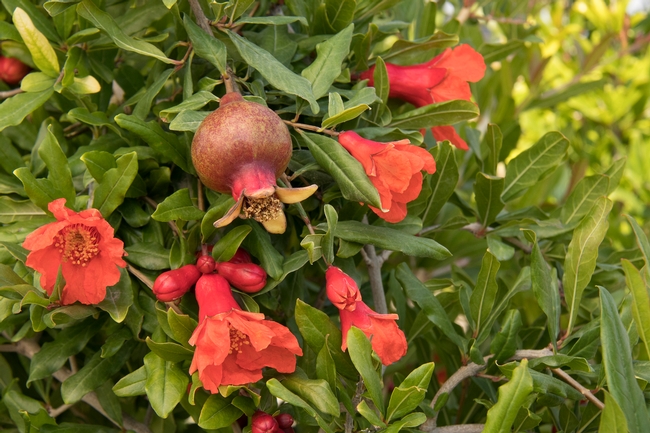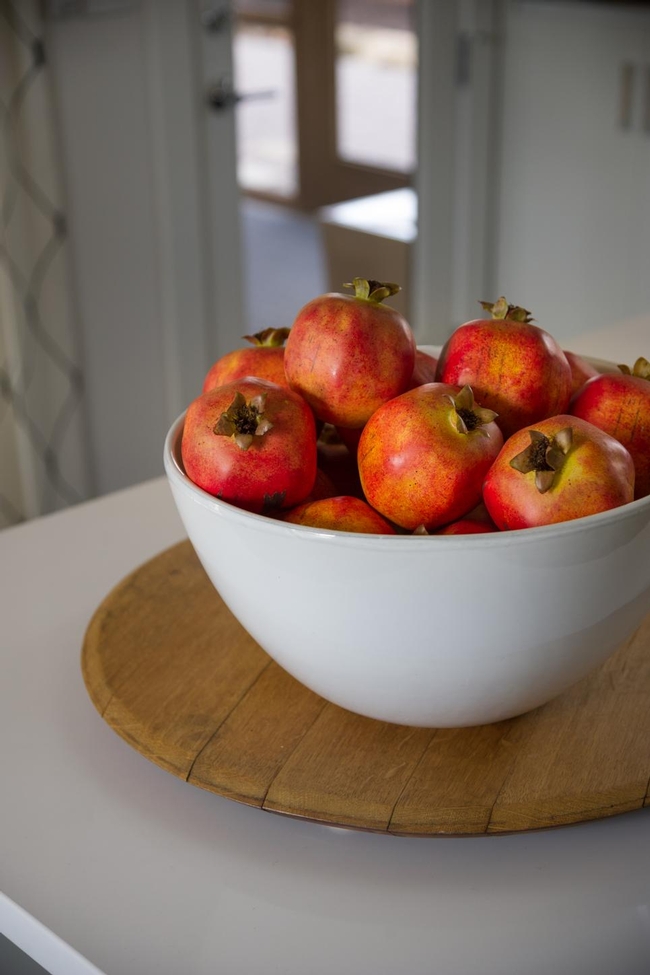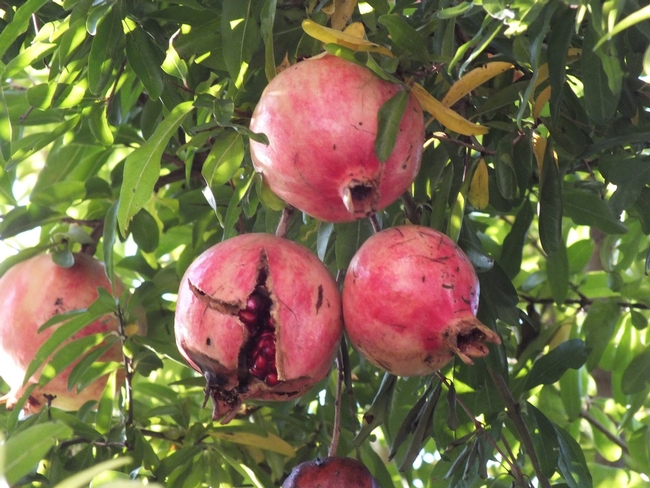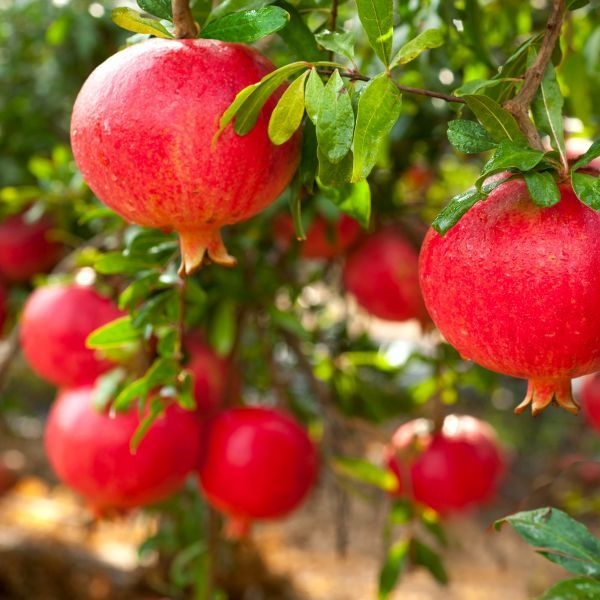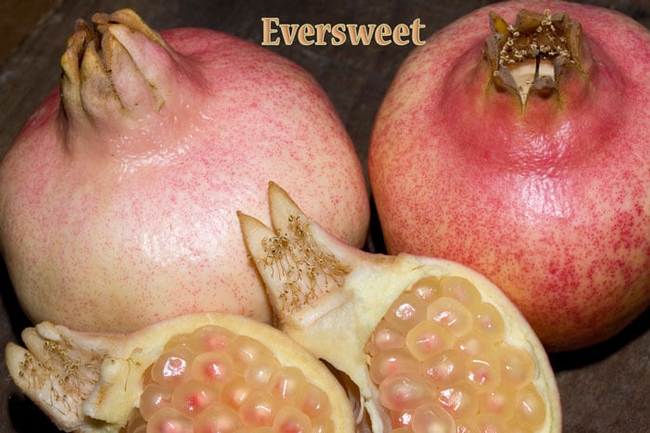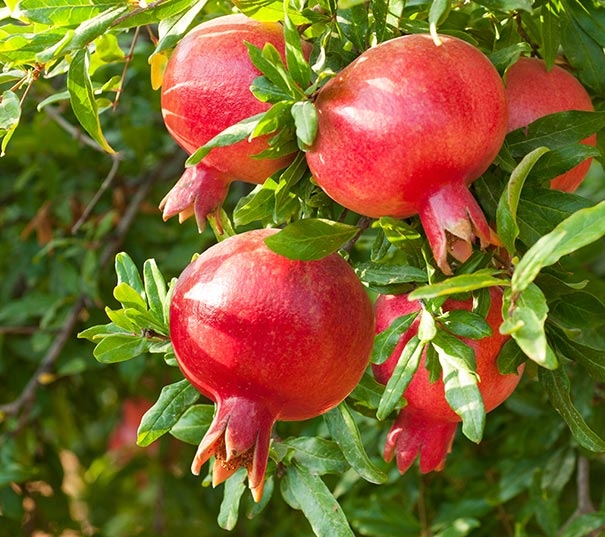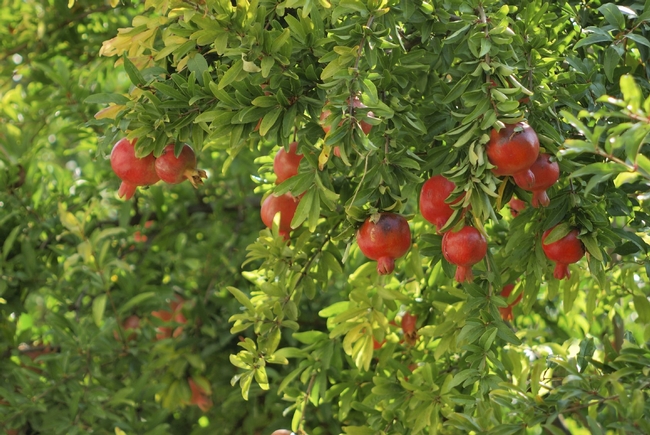By Susanne von Rosenberg, UC Master Gardener of Napa County
Fig trees are among a small group of fruiting trees that have been cultivated for thousands of years. Pomegranates are another member of that exclusive club. (The other two are persimmons and olives.) Like the other members of this club, pomegranates are grown on their own roots. They are propagated by taking cuttings from existing trees and rooting them. You can do this yourself if you know someone who has a pomegranate variety that you can't find at a nursery. Pomegranates grown from seed typically don't produce good fruit.
I like growing pomegranates because they ripen relatively late—in October for most of Napa County, or in September in the hotter areas. They have bright green, shiny foliage and attractive orange-red flowers. And, of course, the ripe red pomegranates hanging on the tree are beautiful.
Pomegranates can tolerate heavy, wet soil and have few pests. The trees have a low winter-chill requirement, which makes them suitable for our warming climate. They are also relatively drought- and salt-tolerant. They need less water than most fruit trees, although they do need some supplemental water to grow and bear well.
Pomegranates can be long lived; some specimens in Europe are known to be more than 200 years old, although they tend to lose vigor after 15 years. Unless you intend to make a lot of juice or syrup, you probably wouldn't miss the extra fruit. I always end up with a lot to give away. Another thing I like about pomegranates is that gophers tend not to go after their roots.
Although pomegranates have many wonderful qualities, many people find it challenging to remove the kernels (known as arils). Through online research, I have found easy ways to peel pomegranates so you can just strip off the arils. You can also peel them in a bowl of water to avoid inadvertent sprays of juice or flying arils.
Pomegranates have a shrubby growth habit but can be trained into small trees that can reach 30 feet. I've left mine as shrubs and find that the weight of the fruit bends most of the branches down, so the shrubs stay at around 8 feet for several years without being pruned for height.
In their shrubby form, pomegranates may reach 16 feet. Dwarf varieties, growing 3 to 5 feet tall, also exist. Pomegranates bear fruit on the tips of new growth; the fruit ripens five to seven months after flowering. You can expect a pomegranate to start fruiting two to three years after planting.
Pomegranates come in both fruiting and ornamental varieties, but even the fruiting ones make beautiful additions to the landscape.
The biggest threat pomegranates face is that they tend to crack after the first fall rains, or if you over water late in the season. Once they crack, birds will feast on them, or they will start to mold and rot. You can plant an earlier-ripening variety, such as Parfianka, if you live in an area that receives early fall rains.
Most pomegranate varieties need heat to ripen; one variety, Eversweet, is recommended for coastal areas. Pomegranates sucker heavily from the base. Because these suckers will produce the same fruit as the original plant, you can remove them, or leave them to grow and let your shrub widen.
Pomegranate branches can be spiny. (The popular Wonderful variety has small spines.) Pomegranates are native to an area stretching from Iran to the Himalayas of Northern India and are severely injured at temperatures below 12°F.
We typically think of pomegranates as having dark red seeds, but they arils come in a range of colors from nearly clear to pink and purple. Some varieties have clear or pale juice. The different varieties also range in sweetness from very tart to very sweet. The seeds' size and hardness differ among the varieties as well. The seed is the hard part of the aril.
The fruits' skin color also varies. We're familiar with the dark-red Wonderful, by far the most common variety, but skin color at maturity can also be mostly green, light yellow or pink. A few varieties more commonly grown in other countries (for example, Malissi and Djebeli) are nearly seedless. Standard varieties for California include Ambrosia, Eversweet, Granada, Ruby Red, Early Wonderful and Wonderful. Ambrosia has purple arils; Eversweet has clear seeds and produces clear juice.
Another variety worth considering is Utah Sweet. It has soft seeds and pink arils. Angel is a relatively new variety that has soft red seeds. With so many varieties, there is sure to be at least one you'll love.
Napa Library Talk: Napa County Master Gardeners will give a talk on “Planning a Moon Garden” on Thursday, August 5, from 7 p.m. to 8 p.m. via Zoom. Learn about this ancient nocturnal garden theme and pick up some design tips. Register at http://ucanr.edu/2021AugMoonGarden.
Food Growing Forum: Napa County Master Gardeners will present a discussion of “Herbs and Starting Winter Vegetables by Seed” on Sunday, August 8, from 3 p.m. to 4 p.m., via Zoom. Register to receive the Zoom link: http://ucanr.edu/2021/FoodForumAug
Free Guided Tree Walk: Join Master Gardeners of Napa County for a tree walk in Fuller Park in Napa on Tuesday, August 10, from 10 a.m. to noon. Limited to 12 people per walk. COVID safety protocols will be followed. You will be asked health questions and asked to sign in. Face masks and social distancing are required. Register here.
Got Garden Questions? Contact our Help Desk. The team is working remotely so please submit your questions through our diagnosis form, sending any photos to mastergardeners@countyofnapa.org or leave a detailed message at 707- 253-4143. A Master Gardener will get back to you by phone or email.
For more information visit http://napamg.ucanr.edu or find us on Facebook or Instagram, UC Master Gardeners of Napa County.

